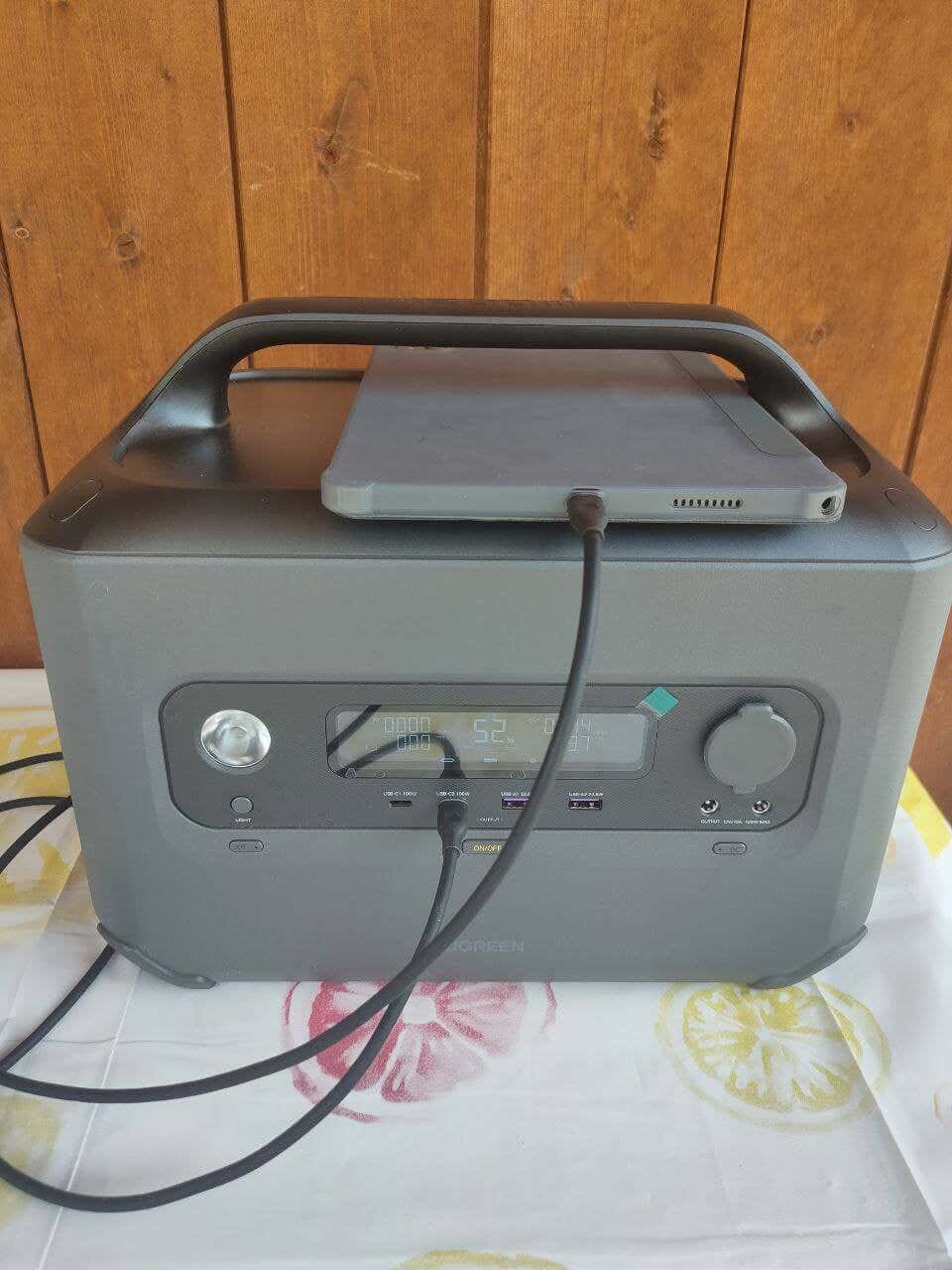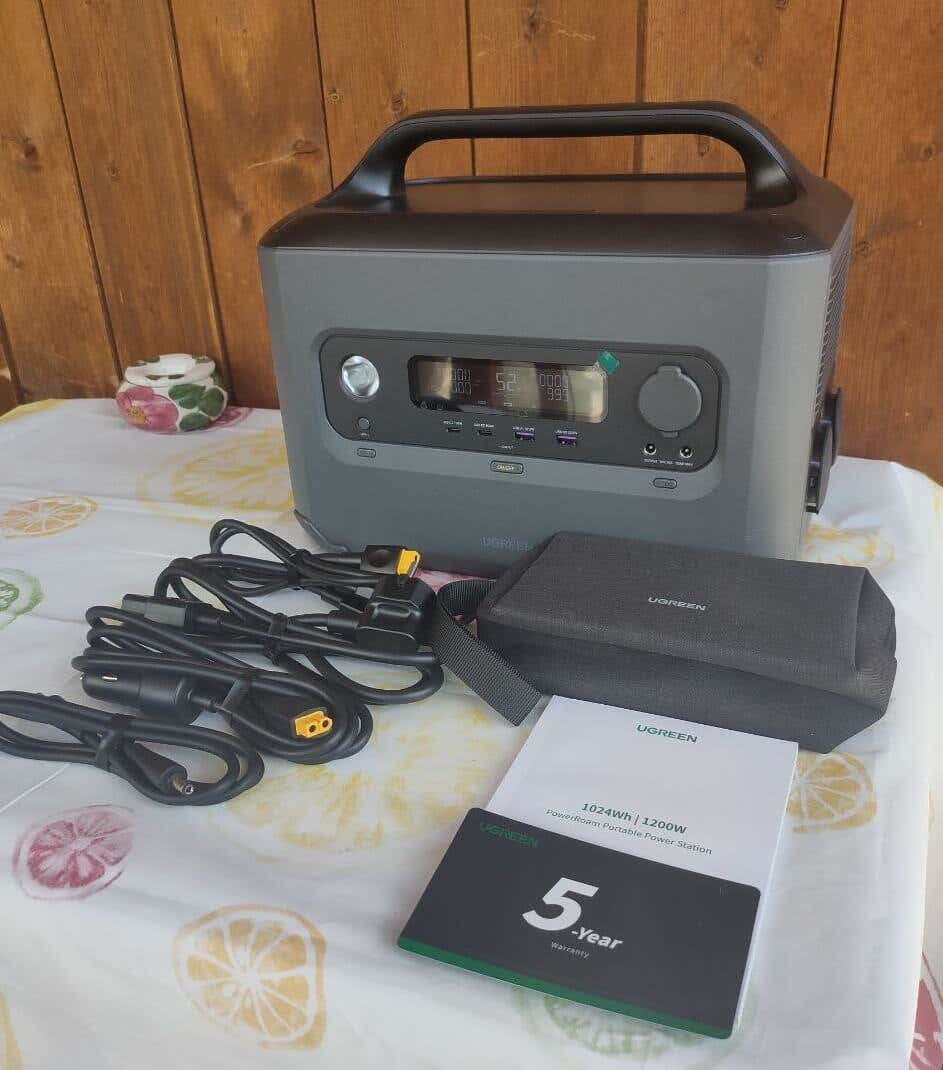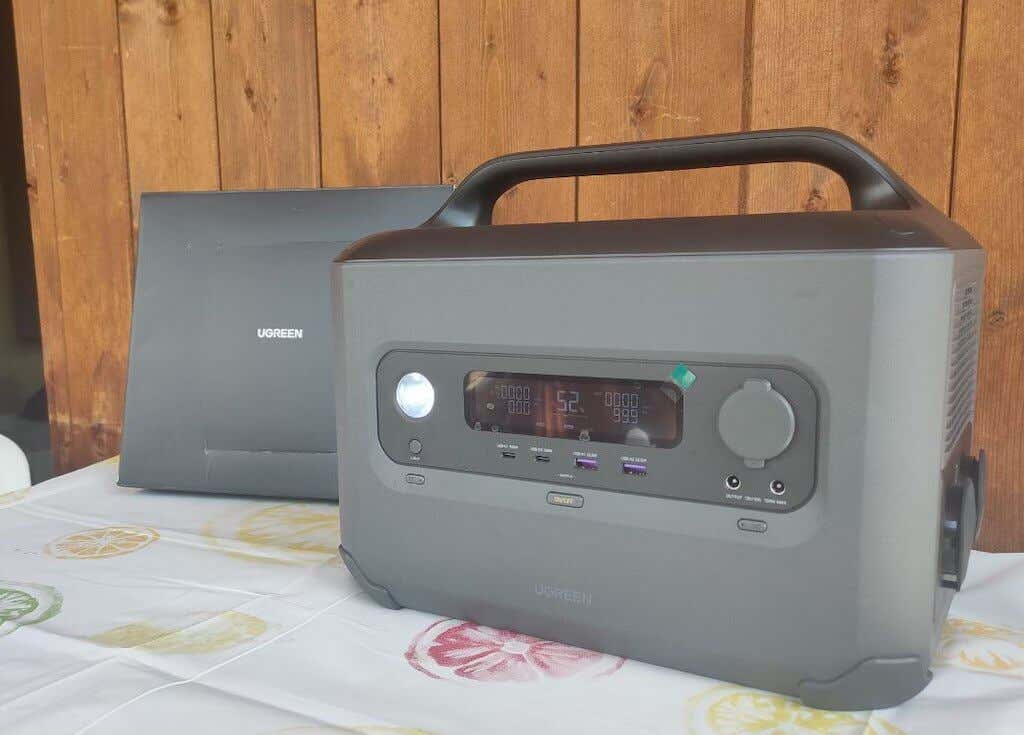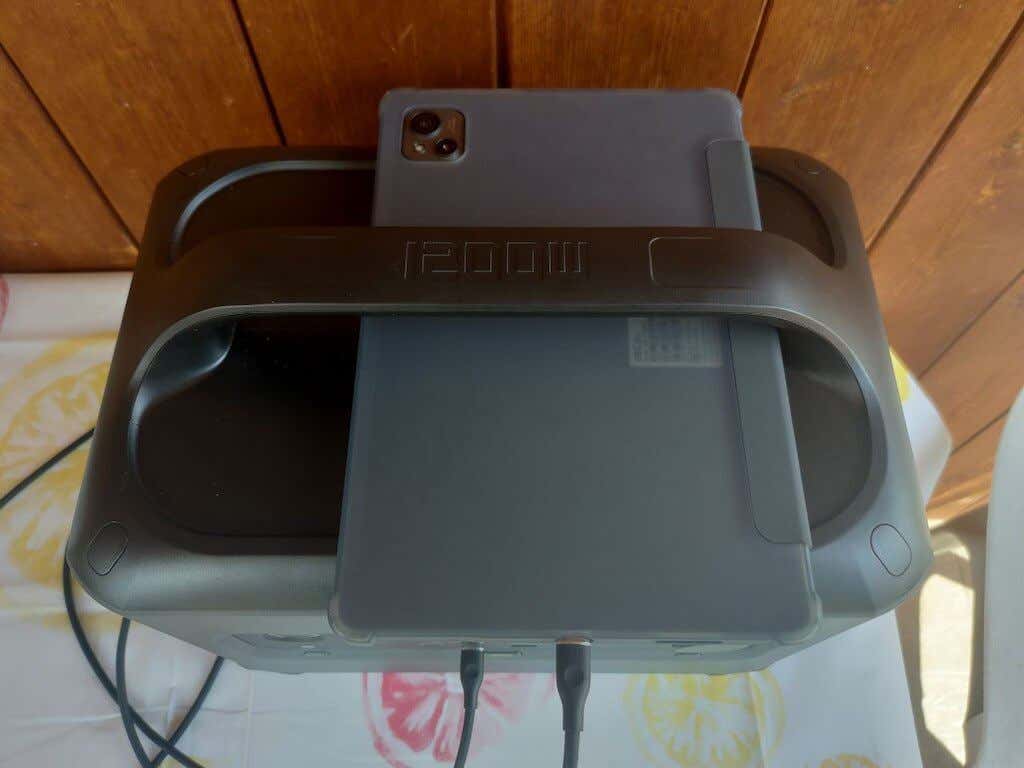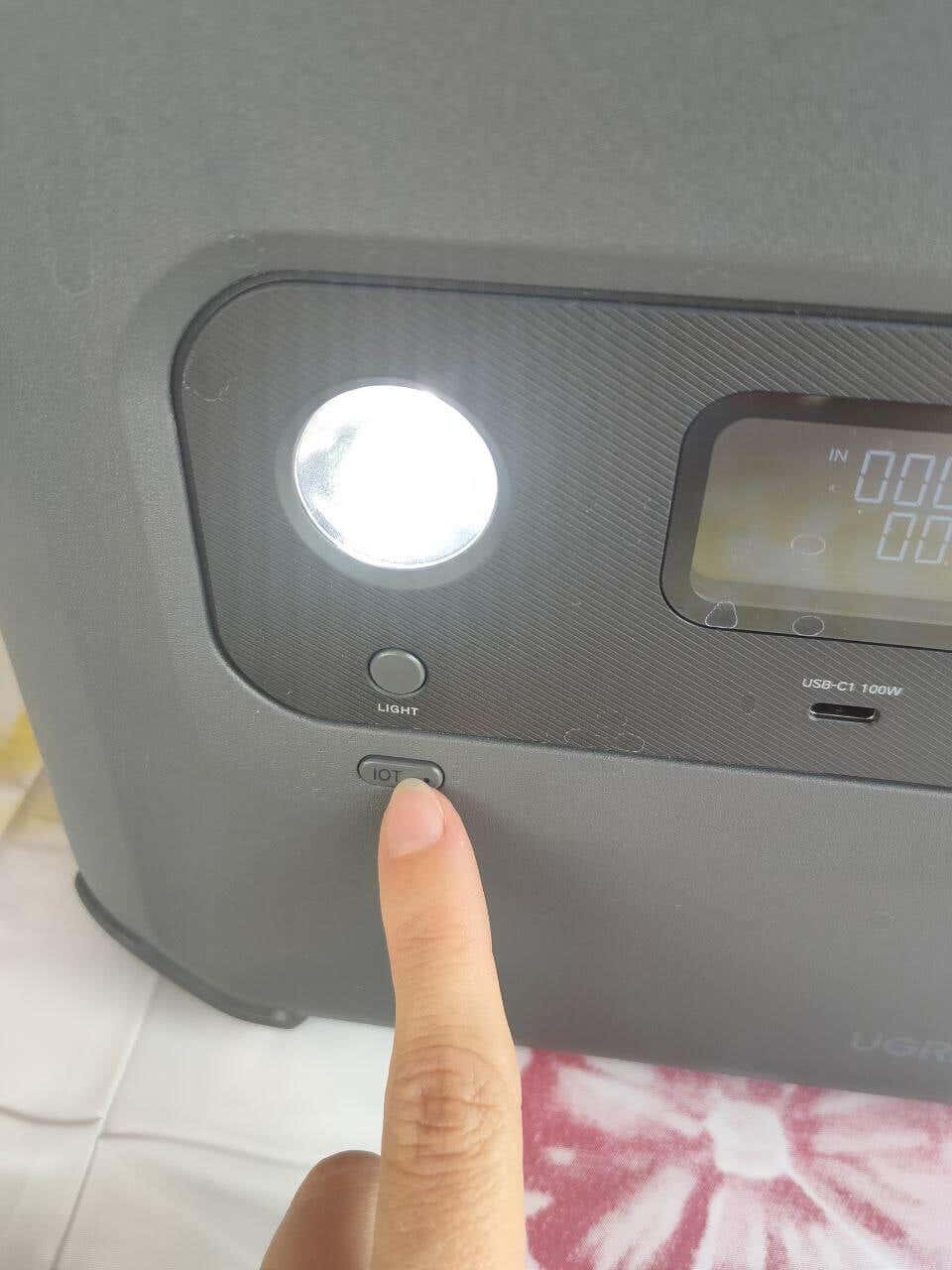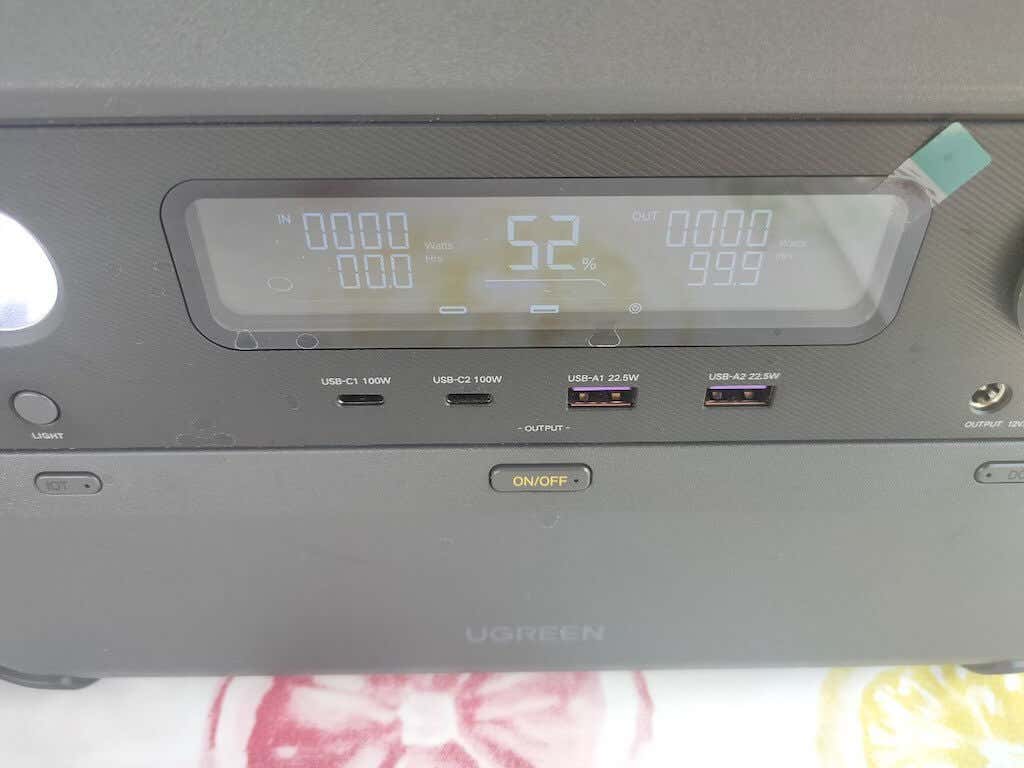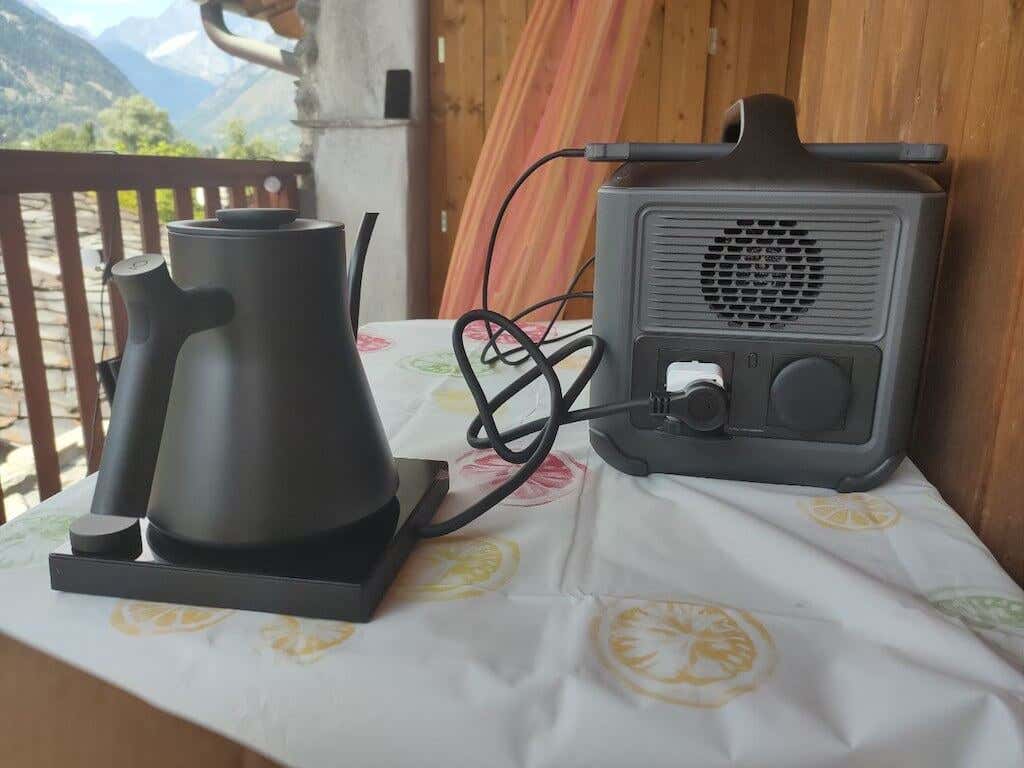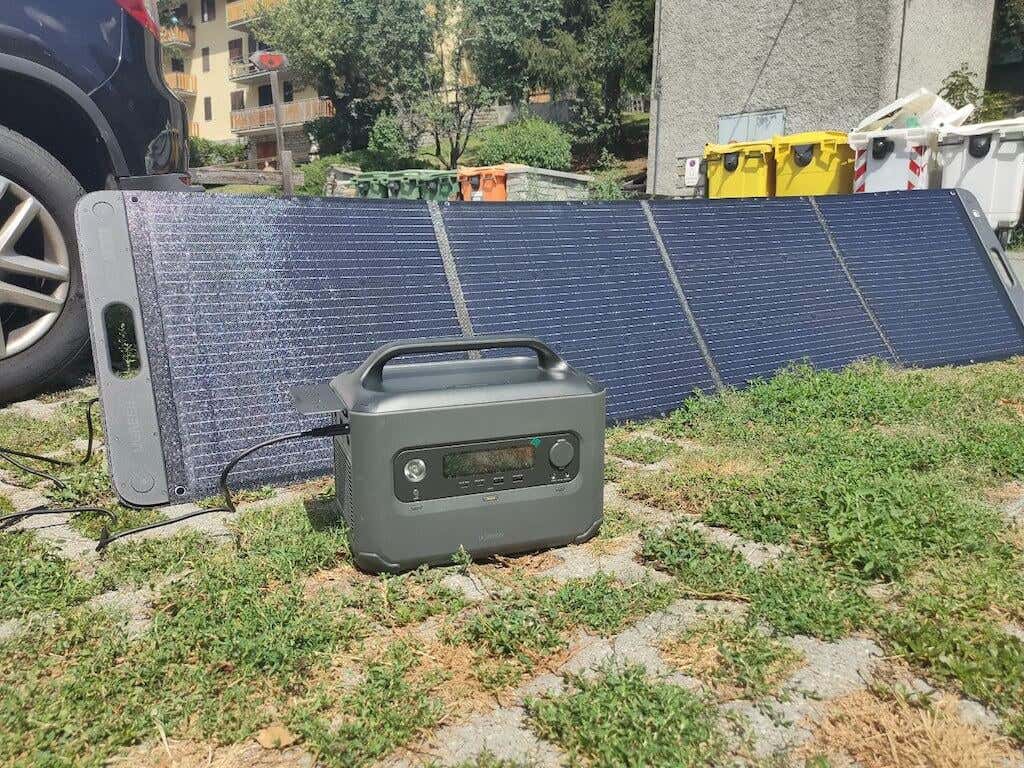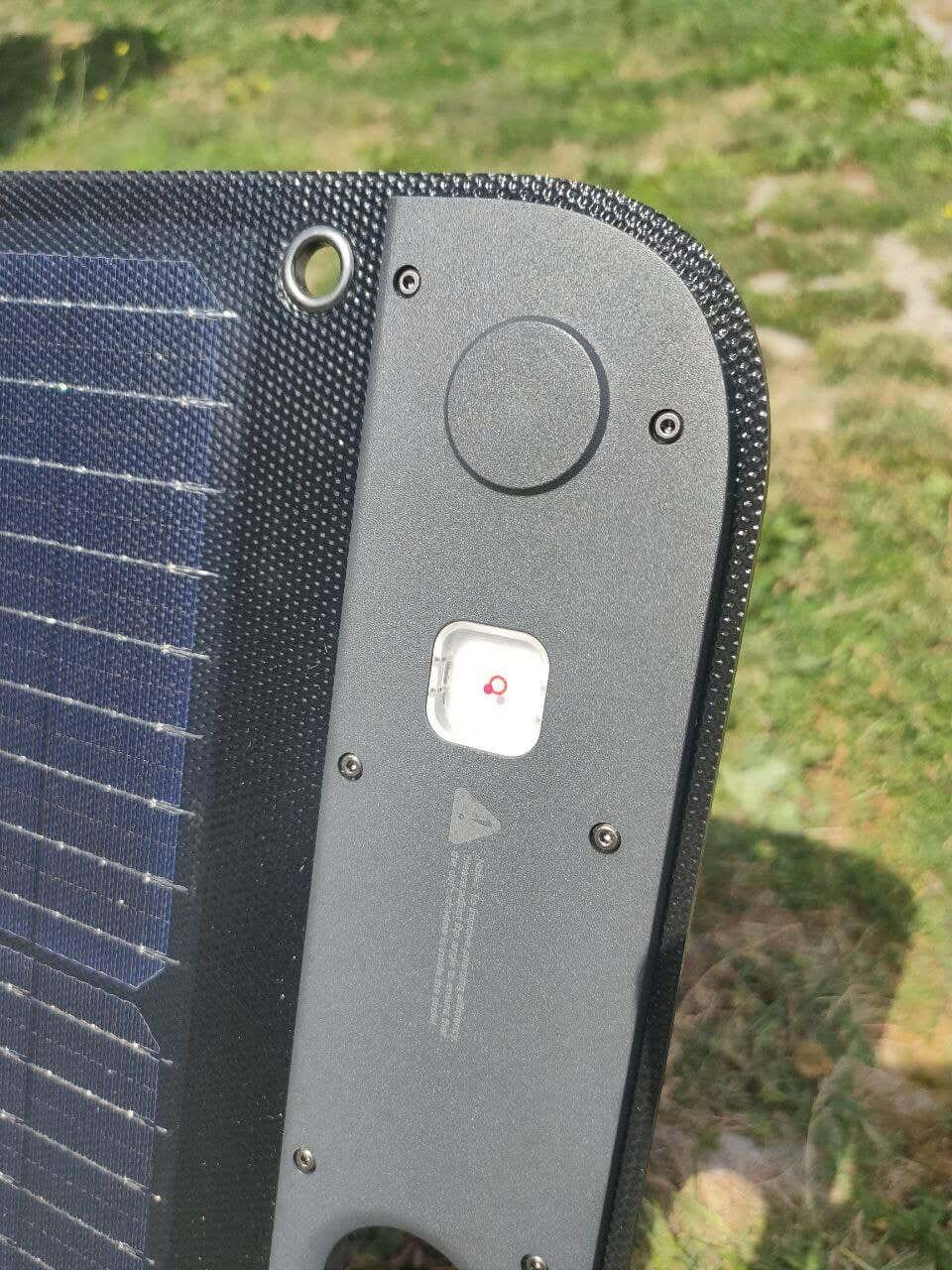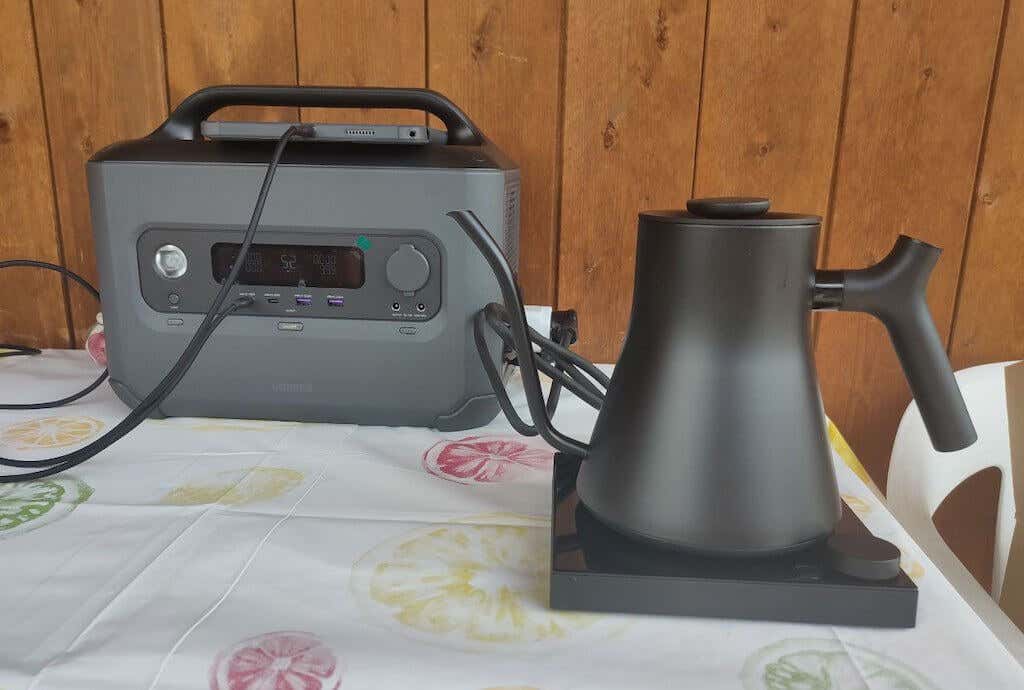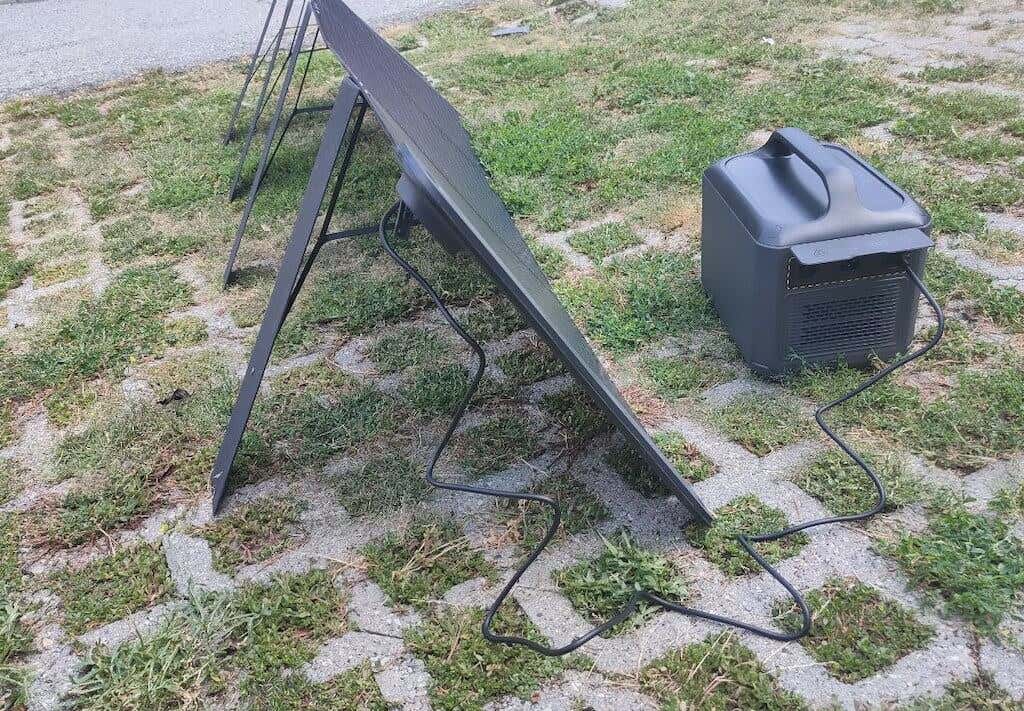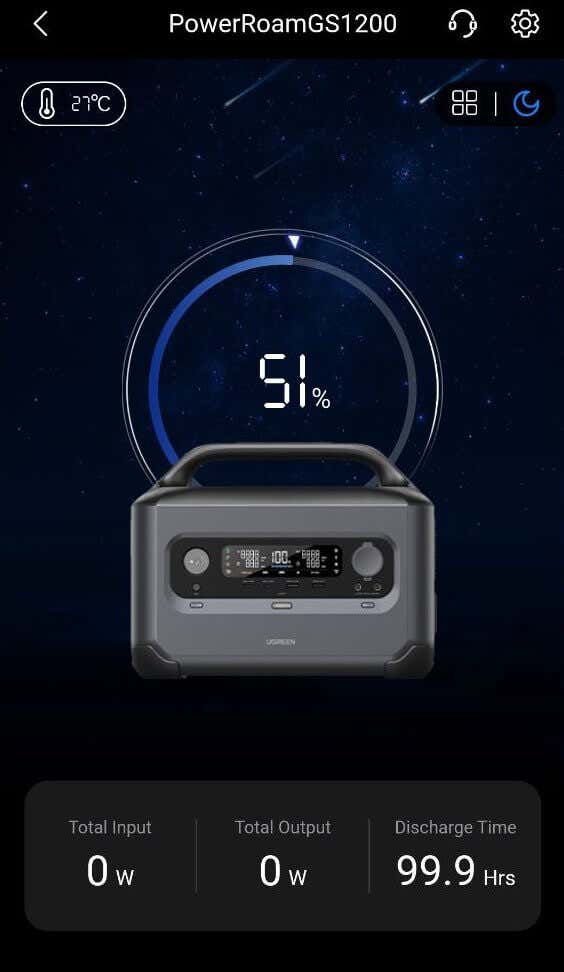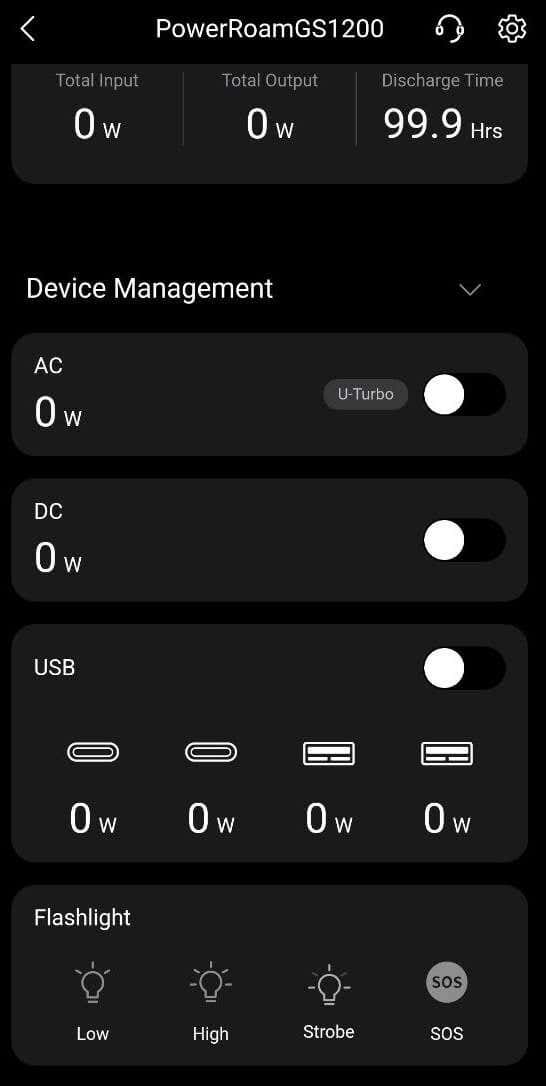Charge phones, run lights and power small appliances
Ugreen is a household brand known for its cables, chargers, and USB hubs. I’ve previously reviewed their 65W fast travel charger and was pleasantly surprised to learn that they’ve developed a portable power station that can function autonomously thanks to the foldable solar panels.
If you’re searching for a portable solution for your off-grid power needs, check out our review of the Ugreen PowerRoam 1200 power station and 200W solar panel to see if this is the right option for you.
UGREEN PowerRoam 1200 1024Wh Portable Power Station & Solar Panel: First Impressions & Specs
The PowerRoam 1200 by Ugreen is an excellent medium-sized portable battery. It can continuously power AC devices up to 1200W (or some higher-powered appliances in UTurbo mode), including high-power USB ports and a built-in emergency lighting system. You can control it with an app over Bluetooth or Wi-Fi, adding to its value.
My previous experience with power stations has been limited to massive power beasts like Anker 757 and 767. And while it’s great to have 2048Wh capacity available, both stations are huge and won’t suit you if you need to carry your power station up and down the stairs more than once. I’ve been looking for portability, and the PowerRoam 1200 fits the bill.
By the way, to avoid any confusion, we first need to state that 1200 refers to the total power output possible, i.e., 1200W, and not 1200Wh of battery capacity. The actual power the PowerRoam 1200 stores is 1024Wh, which is still a lot, but it’s better to have this understanding from the beginning to avoid any disappointment.
Even though Ugreen isn’t that big of a name in the power station market like Anker, EcoFlow, or Jackery, I was surprised by the quality of the station and the portable solar panel.
You can connect up to two 200W portable solar panels to your Ugreen 1200 station. Together, they will charge the station from zero to full in about four to eight hours, depending on the conditions.
Before we dive further into this portable power station review, here’s the full list of specs of the Ugreen PowerRoam 1200:
Brand: UGREEN
Weight: 25.4lbs (11kg)
Size: 13.4 x 8.7 x 10.6 inches (340 x 220 x 270 mm)
Capacity: 1024Wh
Display: 4.7 inch LED display
Maximum discharge: continuous 1200W, surge 3000W (can power some high power devices up to 2500W in UTurbo mode)
Input: solar 400W (XT60), AC 500W
Lifecycles: 3000 to 80%
Battery type: LiFePO4 batteries
Solar Charging: maximum 400W, 12-48V@15A
AC outputs: two AC outlets
USB outputs: two USB-C 100W, two USB-A 22.5W
Other outputs: 12V carport and two DC
Price: from $749.25 on the Ugreen website (with discount coupon), and $999 on Amazon. The 200W solar panel is sold separately ($499.99 on the official website) or in a bundle together with the power station.
Design and Unpacking
The Ugreen PowerRoam 1200 comes packed with features beyond the basics typically found in power stations, making it stand out in its category. Let’s take a closer look at this versatile power station’s design and unpacking experience.
What’s in the Box
Here’s everything you’ll find while unpacking your Ugreen power station:
- Ugreen PowerRoam 1200 power station
- AC power cable
- Car charging cable
- Solar charging cable
- Accessory storage bag
- User manual & warranty card
- 200W solar panel, XT60 to XT60/XT60 to MC4 cable (solar panel sold separately).
In terms of dimensions and weight, the PowerRoam 1200 has a compact build, measuring 13.4 x 8.7 x 10.6 inches and weighing only 25.4 pounds. For its capacity, the PowerRoam 1200 is both portable and lightweight. You can compare it to the Jackery Explorer Pro 1000, which has a similar weight but slightly larger dimensions, showcasing the PowerRoam’s efficient use of space.
Design-wise, the PowerRoam 1200 is simple and practical. There are no bright colors; the station is dark and light gray. If you’re a fan of minimalistic designs, you’ll enjoy this one. The massive handle was the only thing that bothered me about the station’s appearance.
On the one hand, the handle is sturdy and great for picking up and carrying the station around. On the other hand, I use the top of the power station a lot — mostly to put gadgets on while camping. The handle is in the way and limits the available space on top of the station.
Ugreen thoughtfully added a handy zipped case for all your cables as if to balance it out. It easily fits the AC cable, XT60 Y splitter, DC-to-DC cabling, and even a few other cables if you like. The case is a nice touch and ensures you don’t lose anything.
Most of the charging ports are located on the front side of the station, like the two USB-C ports and two USB-A ports. Then, you’ll find the AC ports on the right side and the input ports on the left. The front interface has four buttons, each serving distinct purposes. One button activates the built-in light, another powers the device on and off, the third initiates the DC ports, and the fourth enables the IoT function.
Next to the buttons, you’ll find tiny LED indicators that provide visual cues, such as the status of IoT activation.
The LCD screen on the unit displays 16 different data points. The central figure is the remaining battery percentage. Then, there’s information on current input and output levels and the estimated time remaining for charging and discharging. All these adjust based on charging conditions, especially when using solar power. Unfortunately, the screen’s visibility is somewhat compromised in bright sunlight.
The PowerRoam is also equipped with a flashlight feature, a useful feature for illuminating camping areas or tents. A single button allows you to toggle between lighting modes, including low, high, flashing, and SOS modes.
One problematic area in the station’s design is that the power station has wires protruding from three sides when multiple devices are plugged in. This arrangement makes it difficult to put the unit into confined spaces like a car, as wires will be sticking from all sides of the unit.
Finally, the solar panel is well-designed and proved to be powerful when charging the station. If you’re a beginner and have never used a solar panel, you’ll get the hang of it quickly, as the Ugreen solar panel has clear instructions for using it with your power station. Moreover, there’s a cool angle guide for better output.
You’ll find a clear piece of plastic in the corner of the panel with a dot in the middle. Below the dot, there’s a little space where the dot shines. In the center, there’s a circle with a label. The idea is simple: make the dot match the circle’s center to get the best results. This happens when the sun is at a 90-degree angle. By using this guide to angle your panels correctly, you can add 10-20W to the overall output from your panel.
Performance and Features
This power station is impressively speedy at recharging. On paper, it reaches 80% charge in just 50 minutes when using AC charging, thanks to PowerZip’s fast-charging technology. My tests showed that it can be even faster than that.
The batteries inside, called LiFePO4, have a longer lifespan and are better at releasing power than other lithium-ion batteries. They’re also lighter, which helps to keep the power station’s weight manageable. When plugged into a regular power outlet, the station fully charges in less than an hour.
A pleasant surprise was how quiet it was. You’ll only hear the fans when a lot of power is used, like when boiling water or charging an e-bike. When charging a smartphone or laptop, it’s absolutely silent.
Another neat feature is the 0% Battery Emergency Mode. Even when it shows 0% charge, the PowerRoam can still provide up to seven hours of light and enough power to charge your phone in an emergency. I already had to use this feature once and I have to say knowing you won’t be left in the dark without communication even when the station’s 0% is reassuring.
The Ugreen PowerRoam also comes with an Uninterrupted Power Supply (UPS). If your home’s power goes out, this power station kicks in, allowing your essential devices to keep running.
I also tried out charging the station with the 200-watt Ugreen solar panel. Of course, the results will depend on how sunny it is outside. However, you’re guaranteed great results if the weather is anything like summer 2023. If you position the solar panel correctly (you can consult the angle guide to do this easily), you can get a max of 200 watts on a bright sunny day.
The good news is that the PowerRoam 1200 can pair with two such panels. You can double the wattage, reach 400 watts, and quickly charge your station and supplies using exclusively solar energy.
Software
Setting up the power station is intuitive; you can do it without consulting the user manual. However, it’s best to download the Ugreen app to unleash its capabilities fully. It’s available for both Apple iPhone and Android devices.
The Ugreen app is both simple and informative. You can use it to update your device’s firmware and control its features.
When you open the app and connect it to your power station, you’ll see the amount of power going into and coming out of it. You can also see how much time is left until the battery is full or empty.
Other things you can do in the app include turning different power plugs on or off, adjusting screen brightness, and turning on special sounds. You can also do other things, like using a safety lock, a quiet mode for fans, or putting the station on standby.
The information on the app changes very quickly when things change on the power station. For example, if the % number changes on the power station’s screen, the app’s number changes too, almost immediately, in less than a second.
Battery Life
I already touched on the topic of battery life previously, but charging up the Ugreen PowerRoam is speedy. During testing, I charged the battery from flat to full in about an hour, which is more than impressive.
Once it’s charged, this power station can keep your devices running for quite a while. On average, it will power things for around 8 hours if you use up to 300W. If you’re careful and only use around 100W, it could last approximately 25 hours. It’s like having a big, reliable power bank.
And if you’re out and about with your Ugreen solar panels, you can charge up this power station in about 7-8 hours with a single 200W panel if it’s a sunny day. Just make sure you position the panels where the sun shines best. On a not-so-sunny day, it might take longer, but it’s still a pretty cool way to get free power from the sun.
Should You Buy the UGREEN 1200 Portable Power Station?
Whether you enjoy camping or are worried about what happens when the lights go out due to a power outage, the Ugreen PowerRoam 1200 portable power station could be a lifesaver. It’s like having a backup power source to keep your essential devices running even when the main power is down. With its long-lasting battery and various outputs, you can charge phones, run lights, power small appliances, and stay connected.
If you’re into using renewable energy, the Ugreen 1200 can charge it using solar panels, making it a solar generator of sorts. While it may not be the lightest power station out there, it’s compact and sturdy, and the added solar charging capability makes it a versatile choice for outdoor adventures, camping trips, and even as a reliable backup for unexpected emergencies.


